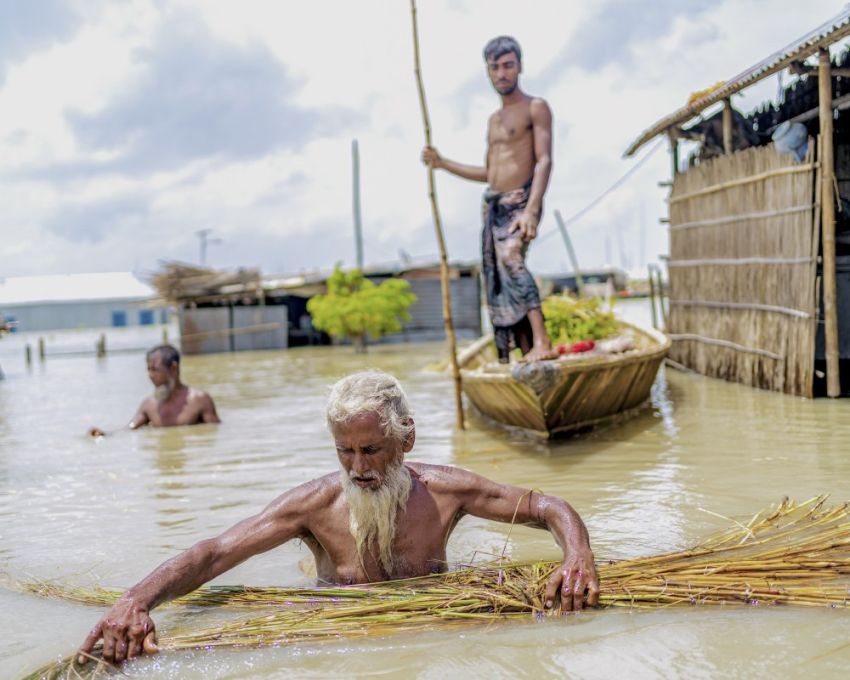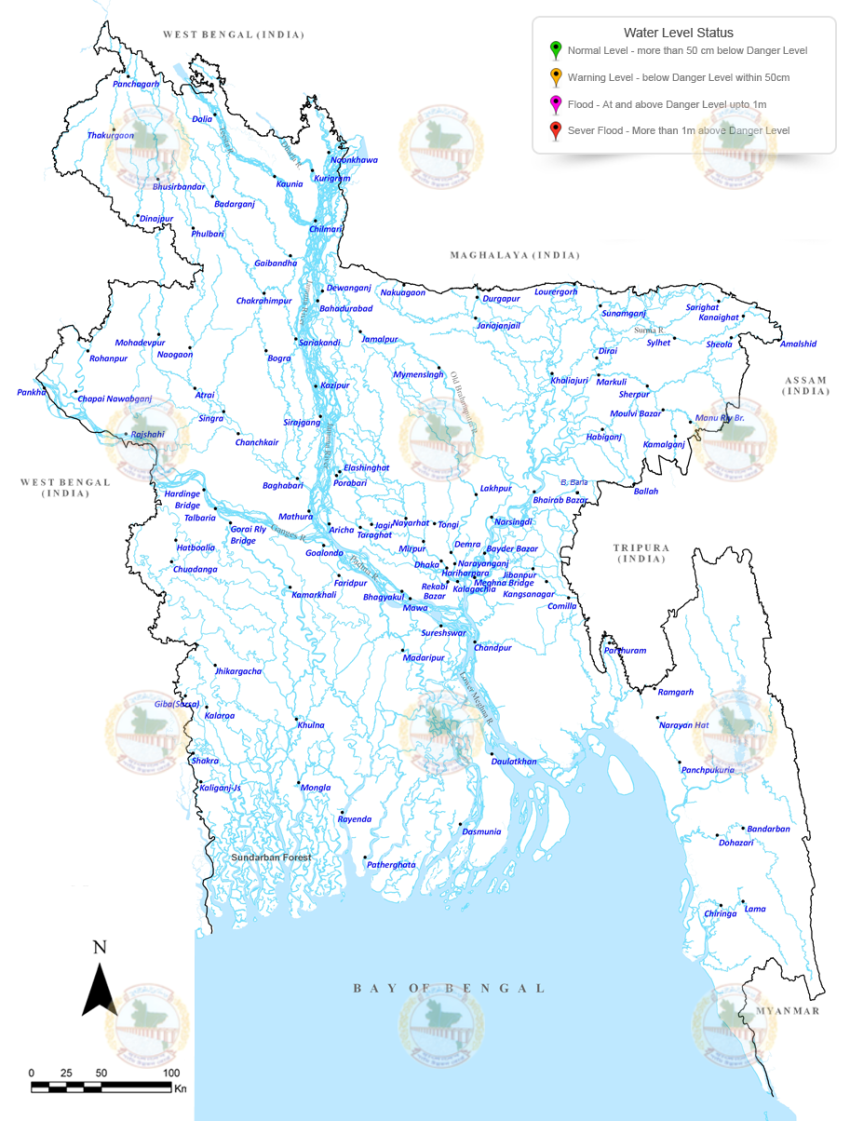
Two months ago, Cyclone Amphan ravaged southwestern Bangladesh, swallowing entire villages along its coast, compounding the annual monsoonal floods. According to media reports, this has resulted in the worst floods in a decade, affecting a third of the country and at least 1.5 million people.
Noor-E-Elahi, program assistant at the International Centre for Climate Change and Development (ICCCAD) told Green Left that catastrophic flooding has become a regular event.
“Each year in Bangladesh, about 26,000 square kilometres (around 18% of the country) is flooded, killing more than 5000 people and destroying more than 7 million homes,” said Noor.
“During severe floods, the affected area may exceed 75% of the country.
“Bangladesh faces the cumulative effects of floods due to water flushing [down] from nearby hills, the accumulation of the inflow of water from upstream catchments and localised heavy rainfall enhanced by drainage congestion.
“Bangladesh faces this problem almost every year and floods are divided into [these] four categories: Monsoon floods caused by major rivers usually in the monsoon during June-September; flash floods caused by over-flowing of hilly rivers in eastern and northern Bangladesh in April-May and September-November; tidal floods caused by storm surges; and local floods caused by drainage congestion and heavy rains.
“Only two months ago, a cyclone pummeled the country’s southwest. Along the coast, a rising sea has swallowed entire villages.
Noor said that while it is too early to ascertain what role climate change has played in these latest floods, “Bangladesh is already witnessing a pattern of more severe and more frequent river flooding than in the past along the mighty Brahmaputra River.”
According to scientists, flooding is projected to worsen in the years ahead, said Noor, as climate change intensifies the rains.
Noor told GL that since the last week of June, “Bangladesh witnessed the first phase of flooding … caused by the onrush of upstream water and heavy downpours, affecting around 15 districts.
“The rising water level in the Brahmaputra, upper Meghna [river], and Padma [river] basin inundated the low-lying areas in the north-eastern districts of Sunamganj, Sylhet and Netrokona, the northern districts of Kurigram, Nilphamari, Lalmonirhat, Rangpur and Gaibandha, the north-west districts of Natore and Noagaon, and the north-central districts of Bogura, Sirajganj, Jamalpur and Tangail.
“A second spell of flooding then started, due to continuing torrential monsoon rain and onrush of water from upstream, affecting another three districts: Faridpur, Shariatpur and Madaripur.”
Noor said the current floods could last until the middle of August.
New research published in the scientific journal Nature found that coastal flooding across the world is set to rise by about 50% in the next 80 years, due to climate change, endangering millions more people and trillions of dollars of coastal infrastructure.
The impacts of the floods on people's livelihoods, land and livestock has been catastrophic.
“Torrential rains have submerged at least a quarter of Bangladesh, washing away the few things that count as assets for some of the world’s poorest people — their goats and chickens, houses of mud and tin and sacks of rice stored for the lean season,” said Noor.
“Flood-affected families who are living in makeshift houses on dykes and roads are suffering from an acute shortage of food, drinking water, and sanitation facilities.
“Flood protection infrastructure such as embankments, dykes, dams and sluices are also damaged. People have to camp out in a makeshift bamboo shelter on slightly higher ground.
“At least they were able to salvage the tin sheet that was once the roof of their house.”
The situation will become particularly dire for people living in the north and north-east, even after the floodwaters subside.
“They are out of work and would be for more one month or two with no income,” said Noor. “Distress sale would be one option, if they have anything left to sell.
Noor said that immediate job creation is an urgent need to ensure survival.
“According to a National Disaster Response Coordination Centre (NDRCC) report, more than 2.4 million people are directly affected by the flood and more than 548,819 families remain waterlogged and have lost their homes in 90 upazilas [administrative regions] and 523 unions [councils] across the affected 18 districts.
“The flood has submerged nearly 62,000 hectares of cropland, damaging crops worth nearly Tk350 crore [A$57 million].
Noor said that further losses are expected.
“Sources at the Department of Agricultural Extension (DAE) said crops on thousands of hectares of land had been inundated,” said Noor. “Due to lasting floods in vast areas of the north, farmers there may not cultivate Aman [a rice variety] this year because of unavailability of seedlings.”

The poorest people in cities like the capital, Dhaka, have also been badly impacted by the floods.
“Most of the informal settlements in Bangladesh are slums and squatter settlements in the major cities,” said Noor. “Being the capital, Dhaka holds the largest slum settlements in the country.
“Most of the dwellers in the informal settlements are migrants from rural areas, who previously lived in areas hit hard by the impacts of climate change.”
Noor explained that geographically, Bangladesh is a climate-vulnerable country faced with multiple climate-induced hazards and disasters that create unemployment, loss of livelihoods and exemplifies poverty for the rural poor.
“This leaves the already marginalised people with no choice but to migrate towards the cities, which they perceive as a place to survive … with more economic opportunities.
“According to a report by National Geographic; on average 700,000 people were internally displaced each year over the last decade with up to 400,000 migrants arriving in Dhaka per year.
“Though migrating to an unfavourable environment is not easy for these rural poor as they start living in slums with miserable conditions, they work hard to adapt to the new lifestyle and manage to feed their families with their low but daily income.
“For decades, this has been the scenario in the country. In fact, the prospect of Bangladesh emerging as a 'middle income country' has been made possible by the hard work of a cheap labour force and informal workers."
There is no denying that climate change poses an extreme threat to the population of Bangladesh, due to sea-level rise, flooding and extreme weather.
“Bangladesh, owing to its position on the global map in the South-Asian region, is one of the most vulnerable countries susceptible to climate change scenarios, especially floods,” said Noor.
The floods are also impacting on Bangladesh’s efforts to battle COVID-19.
“The country faced a rapid economic and physical shutdown for more than two months, due to the COVID-19 induced lockdown,” said Noor.
“The lockdown had a severe impact on the income of the urban poor living in informal settlements.
Noor told GL that, according to a study conducted by Light Castle Partners, hawkers, street vendors and similar job holders witnessed a 70% decline in income, while public transport workers reported a loss of around 50% of their monthly income, due to the pandemic.
“Slum dwellers and other informal settlers were forced to go back to their native villages with minimum or no savings at all.
“Now they are in a more acute crisis, as the opportunities for income, whether from agriculture or other means, have gone down further due to post lockdown impact.
“On top of that, the losses of income caused by the pandemic-induced economic stagnation have made it even harder for affected communities to face the [flood] disaster. As a result, the vulnerable communities living in the affected areas as well as the urban informal settlers that were forced to migrate back to the villages are now trapped in these climate vulnerable hotspots.
“With the rising shortage of water and food, health risks, loss of income, socio-economic insecurities and the risk of exposure to deadly coronavirus for these vulnerable and trapped populations, a prolonged humanitarian and economic crisis is in the offing.
“A timely and well-prepared plan considering short term necessities, mid and long term economic recovery in alignment with climate change projections, and proper execution of the plan is a must needed formula to save the trapped population.
The flood situation is improving, said Noor, and meteorologists and hydrologists are predicting “hardly any chance” of further flooding this year. People have started to return home.
“However, the damage is heavy. Croplands are still under water. In Kurigram around 350,000 people from 56 unions have been affected and now are going through the struggle to resettle.